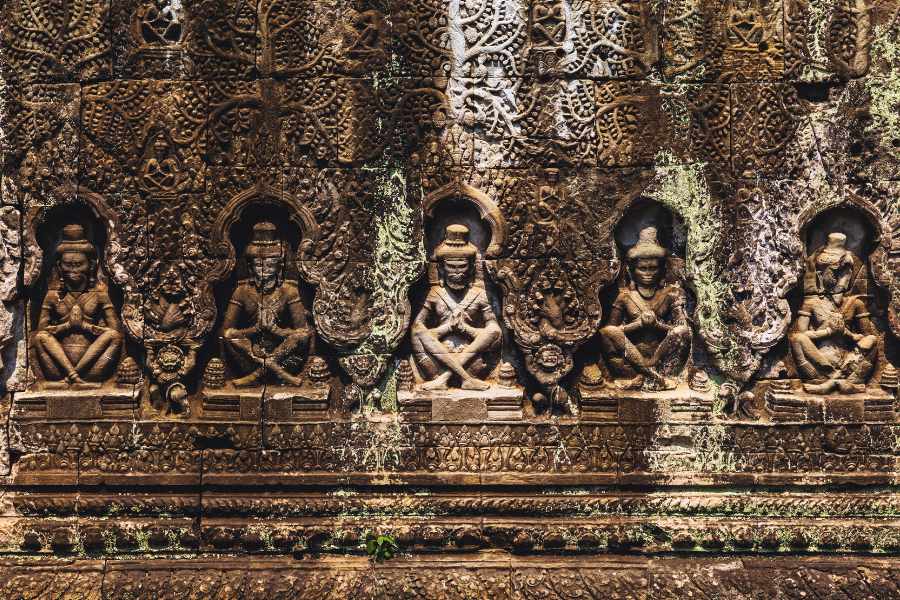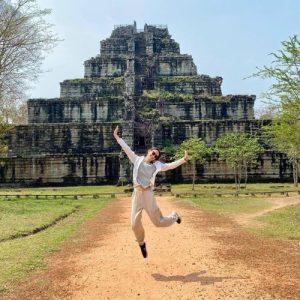Ever thought you might offend the locals at a temple? I’ve visited over 100 Buddhist temples in Southeast Asia. I learned that knowing how to act is key for a good visit. Let’s look at the rules to follow and avoid during your trip to Cambodia.
Understanding dress codes and how to talk to monks is important. Did you know pointing with your index finger is rude in temples? Or that women shouldn’t give things directly to monks? These are just a few things to know about Cambodia’s culture.
This guide will give you tips to be respectful in Cambodia. Whether you’re going to Angkor Wat or a small local temple, these tips will help you be considerate and respectful.
Key Takeaways
- Cover shoulders and knees when visiting temples
- Remove shoes and hats before entering temple buildings
- Avoid touching Buddha statues or pointing feet towards them
- Use an open right hand, palm up, instead of pointing with your index finger
- Ask permission before taking photos inside temples
- Greet monks with a respectful bow
- Refrain from public displays of affection in temple areas
Discover the Top 7 Mistakes to Avoid & How to Be a Respectful Visitor at Cambodia’s Sacred Temples!
1. Understanding Cambodian Culture and Buddhism
Buddhist traditions in Cambodia shape the nation’s heart. About 80% of Cambodians follow Theravada Buddhism. This faith is key in daily life. Buddhism has roots here since the 5th century CE.
The Significance of Buddhism in Cambodia
Theravada Buddhism is big in Cambodia, being the state faith since the 13th century. It teaches enlightenment through meditation and being good. Buddhism touches all parts of life, from birth to death.
Key Cultural Values and Beliefs
Cambodian culture respects Buddhism deeply. People value order, respect for elders, and being good. These beliefs shape how people act and live together. The krama cloth shows how culture and life are connected.
The Role of Temples in Cambodian Society
Temples are key in Cambodia. They’re spiritual centers and protect cultural heritage. I’ve found they’re not just for worship. They’re where people learn, meet, and connect.
2. Dressing Appropriately for Temple Visits
The Angkor Wat dress code is key for a respectful visit. This UNESCO World Heritage Site has strict rules on what to wear. Let’s look at what to wear at Angkor Wat for a smooth visit.
Modest clothing guidelines
Remember, you must cover your shoulders and knees. I suggest wearing loose, breathable fabrics like cotton or linen. Choose trousers, long skirts, or dresses that go below the knee. Don’t wear tight or revealing clothes, as they’re not right for this place.
Footwear etiquette
Wear comfy, covered shoes for your visit. You’ll be walking on dusty paths and climbing stairs. So, supportive shoes are important. Always take off your shoes before going into temples as a sign of respect.
Accessories and hat rules
Keep accessories simple and modest. Take off your hat when you go into shrines. I always bring a scarf or sarong to cover up if needed. It’s a useful item that helps you follow the dress code if your clothes are not enough.
By following these rules, you’ll show respect for Cambodian culture. You’ll have a positive experience at Angkor Wat. Remember, dress codes are for everyone and are strictly followed at big temple sites.
3. Proper Behavior Inside Temples
Visiting temples in Cambodia means being very respectful. It’s important to be quiet. Loud talking or being disruptive is not allowed.
There are rules for Buddhist temples. I always keep my feet away from Buddha images. This shows respect. Don’t show love in public inside temples.
Don’t touch or climb on religious things. Many temples have signs at the door. It’s good to read and follow these rules. Some common rules are:
- Removing shoes before entering temple halls
- Using an open palm instead of pointing with fingers
- Speaking in hushed tones
- Refraining from photography in certain areas
By following these rules, I have a respectful visit. It lets me enjoy the spiritual and cultural beauty of the temples.
Ever wondered how to avoid annoying the locals at a temple? I’ve been to over 100 Buddhist temples in Southeast Asia, and trust me, knowing the right way to behave is crucial! Let’s dive into the dos and don’ts for your trip to Cambodia.
Key Etiquette Tips:
- Cover Up: Always cover your shoulders and knees.
- Shoes Off: Take off your shoes and hats before entering temple buildings.
- Feet Away: Never point your feet towards Buddha statues.
- Hand Signals: Use your open right hand, palm up, instead of pointing with your index finger.
- Photo Rules: Ask before snapping pics inside temples.
- Respect Monks: Greet them with a respectful bow and don’t touch them directly.
- No PDA: Keep public displays of affection out of temple areas.
Understanding Cambodian Culture and Buddhism: Buddhism is a huge part of Cambodian life. About 80% of Cambodians follow Theravada Buddhism, which has shaped their daily lives and traditions for centuries.
4. Respecting Buddhist Monks and Nuns
Respecting monks is key when visiting Cambodia. Buddhist traditions are very important here. It’s important to know how to act around monks.
Interaction Guidelines
I say hello with a sampeah, a bow with hands together. I sit lower than monks to show respect. Women should not touch monks directly.
It’s key to use my right hand when giving or getting things from a monk.
Offering Alms Respectfully
Offering alms is a big deal in supporting monks and temples. I give donations in the morning, without touching the bowl. Even a little bit helps a lot.
In some cases, women give donations to a man first.
Photography Etiquette Around Monks
I always ask before taking pictures of monks. It’s best to stay back and not disturb them. I don’t eat near monks after noon, as they might be fasting.
Following these rules shows respect for Cambodia’s Buddhist ways. Sadly, 80% of tourists don’t act right at temples. I think everyone should respect these places and traditions.
Engaging with Locals:
- Observe Quietly: Watch from a distance and don’t interrupt rituals.
- Join Respectfully: If invited, follow local customs and rituals.
5. Temple Photography Rules and Restrictions
I love taking pictures during my Cambodia temple tour. I always follow the temple photography rules. At Angkor Wat, I look for “No Photography” signs before I take pictures. It’s important to respect these rules to keep the place sacred.
Inside temples, I don’t use flash. This protects old paintings and artifacts. I also don’t take pictures during worship or ceremonies without permission. It’s how I show respect.
Here are some dos and don’ts at Angkor Wat for photography:
- Do be mindful of other visitors
- Don’t block pathways while taking pictures
- Do ask before photographing specific areas or statues
- Don’t use drones without prior written permission
For professional or commercial photos, you need a special permit from the APSARA National Authority. For my personal photos, I aim to capture the beauty of Cambodian temples. I do this while respecting local customs and rules.
Proper Behavior Inside Temples:
- Stay Quiet: Speak softly and avoid being disruptive.
- Respect Artifacts: Don’t touch or climb on religious objects.
- No Flash Photography: Respect signs and avoid using flash.
- Mind Others: Be considerate and don’t block pathways.
- No Drones: Get permission for drone use.
- Follow Signs: Respect “No Photography” signs and avoid using flash.
6. Cambodia Temple Etiquette Guide
When I visit temples in Cambodia, I always remember to respect the local ways and sacred places. It makes my visit better and shows I care for these old sites.
Do’s and don’ts at Angkor Wat
At Angkor Wat, I stick to the paths and don’t climb on the structures. I listen to the rules about when to visit and where to go. It’s important to wear clothes that cover your shoulders and knees. I also give small donations to help keep the temple up.
Many people come to see Angkor Wat every year. So, what we do matters a lot.
Bayon Temple visitor tips
At Bayon, I take my time when taking pictures of the face towers. I keep an eye on others and speak softly. I take off my shoes inside and don’t touch the Buddha statues. These tips are good for all temples in the area.
Ta Prohm etiquette essentials
At Ta Prohm, I don’t touch or climb on the tree-covered ruins. I ask before taking pictures of people and don’t use flash. It’s a big no-no to litter. By doing this, I help keep these amazing places beautiful for others to see.
Visiting temples in Cambodia is more than just looking around. They are places of worship that need our respect. By following these rules, I make sure my visit is respectful and meaningful.
7. Understanding Sacred Symbols and Artifacts
I’ve learned that Buddhist temple etiquette is more than just dressing right. It’s about respecting symbols and artifacts that mean a lot in Cambodian temples. When I go to temples, I always show great respect to Buddha statues.
Significance of Buddha Statues
Buddha statues are very special. I never touch, sit on, or pose with them in a bad way. Each statue shows a special message from Buddhist teachings. For example, a Buddha with a raised hand means protection. A Buddha with hands in the lap is meditating.
Proper Interaction with Religious Objects
Being careful with religious artifacts is part of sacred site etiquette. I don’t move or touch things on altars. Prayer flags and offerings are left alone. In Cambodia, over 300 statues were given to Angkor Wat in the 17th century. This shows the long tradition of giving to these places.
Respecting Prayer Areas
In prayer areas, I keep it quiet and think deeply. It’s important not to bother people who are praying. The big shrine at Angkor Wat is about 65 meters tall. It’s a place that makes you feel small but in a good way. Knowing about these places makes my visit better and helps me not make mistakes.
Timing Your Visit: Best Practices
Planning your visit to Cambodia’s temples is key. Visit from November to February for cooler weather, perfect for exploring. Temperatures are between 21°C and 32°C.
For Angkor Wat, come early in the morning or late afternoon. This avoids the hot sun and crowds. The 3-Day Angkor Pass costs $62 and lets you visit at your own pace. Angkor Archeological Park is huge, covering 400 square kilometers with over a thousand temples.
Respect the opening and closing times of the temples. Some are great for watching sunrise or sunset. I’ve found lesser-known temples to be peaceful. But, big Buddhist holidays can make places busier and more lively.
For a cheap way to see things, rent a bike for $5-6 a day. Or, choose a guided tour for $20 to $115 a day. Always drink water and rest in the shade. These tips will make your visit to Cambodia’s temples amazing!
Engaging with Local Worshippers
Respecting Cambodian culture is important when you visit temples. These places are not just for tourists. They are where people go to worship. I make sure to watch from a distance and be quiet.
Observing without Disturbing
Buddhist traditions in Cambodia are a big part of everyday life. Watching locals pray and meditate is interesting. I don’t get too close or interrupt, especially during ceremonies.
This lets me enjoy the real spiritual feel without bothering anyone.
Participating in Rituals Respectfully
Sometimes, locals ask me to join in rituals. It’s a big honor. I follow their lead and do what they do. I take off my shoes before going into temples and wear modest clothes.
This shows I respect their customs.
Learning Basic Khmer Phrases
Knowing a few Khmer words helps a lot. I say “sua s’dei” for hello and “orkun” for thank you. People like it when I try to speak their language.
It makes talking to them easier. I also learn to greet the traditional way by pressing my palms together and bowing.
Doing these things has helped me understand Cambodian culture better. It makes my visits to temples more meaningful and respectful.
Angkor Wat Visitor Trends: From Pandemic Plunge to Peak Popularity & Cultural Significance
Visitor Statistics
- Annual Visitors: Angkor Wat attracts approximately 2.6 million visitors each year, making it one of the most popular tourist destinations in Southeast Asia. This number has seen fluctuations, with a significant drop during the COVID-19 pandemic, where visitor numbers fell to around 300,000 in 2020.
- Visitor Demographics: The majority of visitors are international tourists, with significant numbers from the United States, China, South Korea, and France.
Cultural and Religious Context
- Buddhism in Cambodia: About 80% of Cambodians practice Theravada Buddhism, which has been the state religion since the 13th century. The influence of Buddhism permeates daily life, cultural practices, and national identity.
- Historical Significance: The construction of Angkor Wat began in the early 12th century during the reign of King Suryavarman II. Originally built as a Hindu temple dedicated to the god Vishnu, it gradually transformed into a Buddhist temple by the end of the 14th century.
Temple Etiquette and Regulations
- Dress Code Enforcement: Since 2016, strict dress codes have been enforced at Angkor Wat, requiring visitors to cover their shoulders and knees. Non-compliance can lead to denial of entry.
- Environmental Regulations: Angkor Wat has been a smoke-free zone since 2012, reflecting a commitment to maintaining the sanctity and health of the environment around the temples.
Historical Comparisons
- Visitor Trends Over Time: In 2000, Angkor Wat received about 700,000 visitors, showing a dramatic increase in popularity over the past two decades, with peak years such as 2019 reaching over 2.6 million.
- Cultural Heritage Recognition: Angkor Wat was designated a UNESCO World Heritage Site in 1992, which has helped raise awareness and funding for its preservation.
Sustainable Tourism at Cambodian Temples
Exploring Cambodia’s temples shows me how vital sustainable tourism is. I aim to keep these places safe for the future. Since 2016, Angkor Wat has made visitors dress modestly to honor the temples.
I always wear clothes that cover my knees and shoulders. This shows respect for the local culture.
Being kind to the environment is part of sustainable tourism in Cambodia. I use the bins to throw away my trash. Since 2012, Angkor Wat has been a smoke-free zone. I follow the rules to protect the ancient buildings.
I keep off the paths to avoid harming the temples. This helps them last for a long time.
Respecting monks and local ways is key. I keep my distance from monks and ask before touching them. I’ve learned that Siem Reap is full of traditions. Knowing these traditions makes my visit better.
By being mindful, I help keep the temples beautiful and full of spirit. This way, they can be enjoyed by others in the future.






